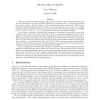Free Online Productivity Tools
i2Speak
i2Symbol
i2OCR
iTex2Img
iWeb2Print
iWeb2Shot
i2Type
iPdf2Split
iPdf2Merge
i2Bopomofo
i2Arabic
i2Style
i2Image
i2PDF
iLatex2Rtf
Sci2ools
98
Voted
APAL
2008
2008
On the unity of duality
Most type systems are agnostic regarding the evaluation strategy for the underlying languages, with the value restriction for ML which is absent in Haskell as a notable exception. As type systems become more precise, however, detailed properties of the operational semantics may become visible because properties captured by the types may be sound under one strategy but not the other. For example, intersection types distinguish between call-by-name and call-by-value functions, because the subtyping law (A B) (A C) A (B C) is unsound for the latter in the presence of effects. In this paper we develop a proof-theoretic framework for analyzing the interaction of types with evaluation order, based on the notion of polarity. Polarity was discovered through linear logic, but we propose a fresh origin in Dummett's program of justifying the logical laws through alternative verifica
| Added | 08 Dec 2010 |
| Updated | 08 Dec 2010 |
| Type | Journal |
| Year | 2008 |
| Where | APAL |
| Authors | Noam Zeilberger |
Comments (0)

